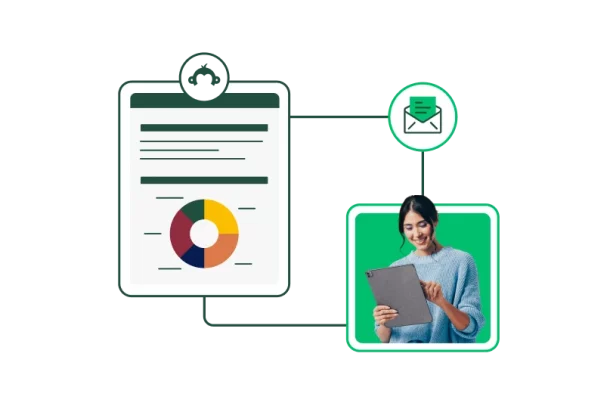How to measure productivity at work
Employee productivity measures how your employees add to your business. Calculate and improve productivity rates.

Employee productivity measures how effective a single employee is at their job role. By measuring productivity, your business can enhance profits, boost customer satisfaction, and create a workplace where your employees love to work.
You can calculate productivity using quantitative and qualitative data, creating a comprehensive picture of an employee's productivity.
Why you should measure employee productivity
Measuring productivity at work allows HR teams to trace the employee experience and positively iterate to create a better workspace for all. Rather than micromanaging employees, measuring productivity in the workplace can be a useful way of understanding how employees feel.
Highly engaged employees are more likely to be more productive at work; an engaged employee is around 22% more productive. Conversely, disengaged employees will exhibit low productivity rates. Monitoring general productivity can help you better improve your employee experience.
Here are some more reasons why you should measure employee productivity:
Improve customer satisfaction
Highly productive employees are likely to go that extra mile for your customers. Customers who interact with motivated, engaged employees will have a better experience with your business.
Improving employee experience to enhance productivity can inadvertently improve customer satisfaction rates.
Increase profitability
When employees are more productive, they finish tasks quicker, close our projects more rapidly, and contribute to the smooth running of your business. Monitoring productivity allows you to enhance it over time, creating more profit for your brand in the long run.
Your employees are at the center of everything your business does. When they feel great, everything flows smoothly.
Identify problem areas
When measuring employee productivity, you can actively identify potential problem areas that are demotivating your employees. Whether those reasons are due to having too much work or lacking certain forms of compensation, tracking productivity can point you in the right direction.

How to measure employee productivity
You can measure employee productivity both quantitatively and qualitatively. Formulas can calculate exact productivity rates, and employee surveys can help you understand why these rates are how they are.
Here are a few methods that can help you track productivity:
Track the productivity types
Tracking each of the four types of productivity can give your business greater insight into an accurate representation of employee productivity. These types include:
- Labor productivity: The total amount of product produced per worker or per working hour.
- Capital productivity: Subtracting the cost of creating your company’s product from your total capital.
- Material productivity: The number of products your company produces compared with the resources you need to create them.
- Total productivity: Total productivity sums up all three of the above and measures productivity by taking every factor into account.
Some businesses focus on only one or two, while others track them all. Tracking one doesn’t mean you can’t track another. With that in mind, having the resources to track all of them can help you gain a more complete picture of productivity in your organization.
The productivity formula
To calculate labor productivity, you’ll need to know the value of your output and the total resources used to make that output.
Then, you’ll be able to use the formula: Labor Productivity = Value of Goods and Services / Input of Resources.
Suppose your business made $10,000 worth of goods across 200 hours of employee work. The productivity rate in that scenario would be 10000 / 200 = $50/h productivity rate.
You can track your productivity rate changes over time, which will help you understand how each of your teams is performing.
Productivity tracking software
You can use productivity tracking software to monitor the various productivity types. Productivity tracking software can include:
- Calculators: Employees input (or the system automatically collects) their hours for a task. A business assigns a task a monetary value. With those data points, the system can calculate a relative productivity rate.
- Task Monitors: Task monitors actively track employee progress on a task. This could be done by monitoring computer activity or checking in with employees. It’s important to note that on-computer software can be intrusive to some employees, leading to lower job satisfaction.
- Project Management Trackers: This form of productivity software allows employees to input the hours spent on a project. Once a project moves to a different stage in the product tracking suite, it can calculate the productivity rate of employees in that phase.
Any one of these solutions can help companies better understand how long it takes to complete specific tasks.
Gather feedback with surveys
Another vital method to gather information about productivity rates at work is to turn to your employees. Running an employee feedback program enables you to collect survey responses about how team members feel about their job roles.
Businesses should understand that employee productivity is a reference point for their overall satisfaction and engagement at work. Understanding how your employees feel about their jobs and your company will help you improve their work experiences.
Gathering employee feedback with an employee engagement survey and acting upon it is one of the most effective ways of understanding and improving employee productivity.
Related reading: Employee feedback examples and when to use them

How to improve employee productivity
Improving employee productivity starts with effective measurement. With both quantitative and qualitative data on employee productivity, you can trace how it changes over time. From there, you’ll be able to identify why productivity rates shift in your organization.
Here are some leading strategies to improve employee productivity:
Keep systems simple
The more complicated your systems become, the more time employees spend finishing tasks that add no real value to your business. Consolidating your workforce where possible to have one singular system where all employees can interact and share information is vital.
Keeping your systems as simple as possible reduces the unproductive time between working on projects. Employees will have everything they need to do great work without interacting with complex and time-consuming systems.
Increase employee motivation
Increasing an employee's motivation and engagement at work is one of the main methods to improve overall productivity rates. Improving your employee value proposition is a great way to impact motivation.
SurveyMonkey research suggests that 39% of employees say they’re not well-compensated. By offering better benefits and compensation packages, you can increase your employees' enthusiasm for their work.
Invest in automation
Automation allows your teams to free up their own time for higher-value activities. Employees can leverage automation to finish tasks for them instead of having to finish repetitive and monotonous tasks.
Automating tasks will enhance productivity as your employees can focus on other activities, boosting productivity and improving job satisfaction.
Provide the right tools and training
Productive employees understand their jobs, the systems they need to interact with, and the tools they can use to speed up their work. Training your employees will help them reach new productivity heights.
Employee training is also essential as it gives employees something to work toward. 48% of employees don’t see a clear path for themselves at a company. By providing more training and additional tools, they’ll find new passions and gain a greater sense of purpose for work.
Related reading: Creating feedback-driven employee training
Encourage continuous feedback
Continuously collecting employee feedback can help you identify the systems and processes that your employees use to meet their productivity goals.
Regularly deploying surveys will help you track employee sentiments and frustrations. However, you should not just collect this data; you should act upon it. Showing your employees that you’ve heard their concerns and have made active changes in your organization is a great way to win employee loyalty.
Related reading: Benchmarking data for employee engagement
Measure and improve employee productivity with SurveyMonkey
Employee productivity as a metric provides insight into the value of every action your employees take for your business. Yet, it can also signal employee sentiments, reflecting their engagement and commitment levels.
Learn how SurveyMonkey can help you improve employee engagement and productivity.
Discover more resources

HR toolkit: Make employee experience your competitive advantage
HR leaders can use this toolkit to help drive exceptional employee experiences.

HR leaders explain how to secure buy-in for workplace benefits and wellness programs
How HR can get executive buy-in for workplace benefits and wellness programs.

We asked, you answered: the workplace trends that matter
New research on the employee experience, work-life balance, confessions of in-office and remote workers, and other workplace trends

Staying ahead of HR trends for 2025
Understanding what employees really care about can help HR drive better employee engagement, employee retention, and wellbeing. Find out more.